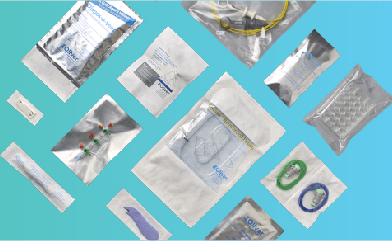With the push for reducing carbon footprint and increasing recyclability in materials becoming greater priorities by the day, med tech producers are looking for new ways to do more with less. Plastic films have long played a major role in the medical packaging industry. Currently, the desire for thinner films is driving the quest for new varieties that will increase performance and address sustainability while reducing costs. Novel film types must maintain the quality and integrity required for medical packaging, as they also respond to trending industry needs.
Abrasion Failures
ASTM F3300 test method covers the determination of abrasion resistance for flexible films and packaging materials. It is also where film thickness comes into play. The test determines the number of cycles it takes for a weighted stylus to completely wear through the material being tested. Microscopic analysis of pinhole breaches and surrounding areas help identify the root cause. This is especially important as we seek to identify what materials best resist abrasion, since it poses a critical risk to the integrity of medical packaging during transit. In the simulated transit environments of packaging validation, ASTM F3300 imitates primary packaging materials abrading against the inside of a shelf carton or the inside of a cardboard box for bulk packaging. Packaging validation is often the last thing a team “gets around to.” As environmental concerns amplify the need for change, incorporating tests like ASTM F3300 will provide reassurance that both existing films and inventive grades to come, continue to meet medical packaging regulatory requirements.
Film Favorites
A high percentage of film laminations used for medical device packaging utilize polyester (PET) or biaxially oriented nylon (BON) as the outer backbone layer. These outer layers provide the bulk of the structure’s resistance to abrasion failures as well as the other key physical properties mentioned. As experimental additives and film compositions emerge, our commonplace test methods may become a true proving ground.
Using Abrasion Testing to Your Advantage
Abrasion resistance is only one of several key performance characteristics that should be considered when determining which film lamination should be used for a specific application. Understanding where the greatest risks for failures are for your application can help you choose the film lamination that is best suited to withstand failure during your packaging validation.
As you work with and through observed film limits and abrasion characteristics keep an eye out for opportunities to ask the “what if” questions. The questions of challenge can be the seeds of breakthrough findings for the future of high-tech films.

.webp)


